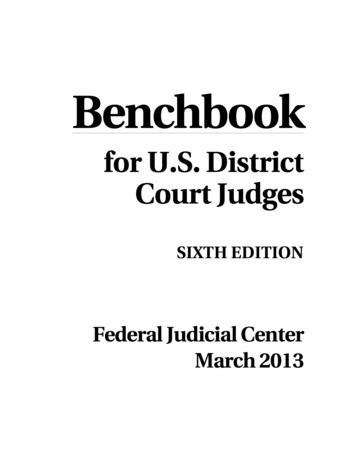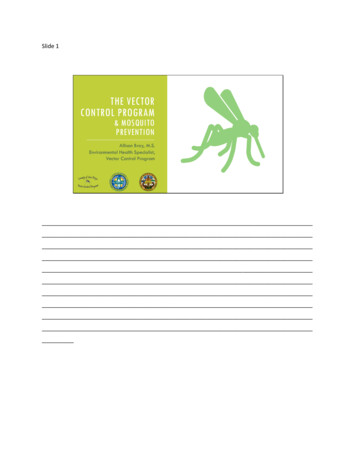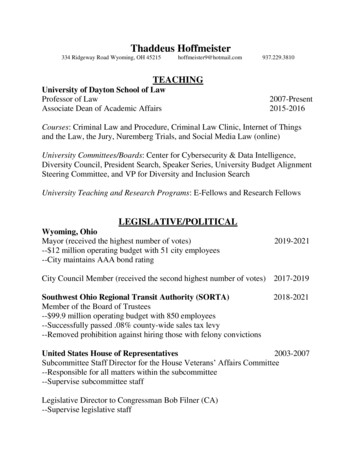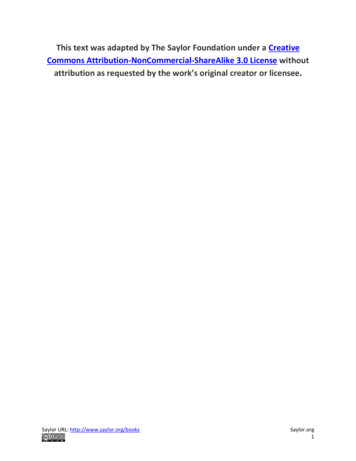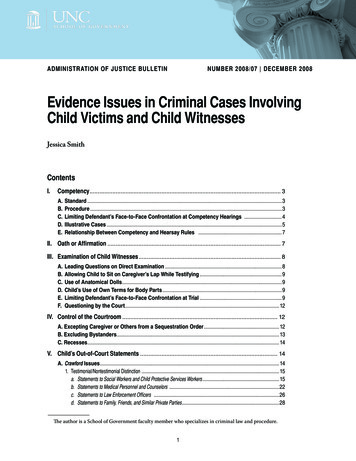
Transcription
Administration of justice bulletinnumber 2008/07 december 2008Evidence Issues in Criminal Cases InvolvingChild Victims and Child WitnessesJessica SmithContentsI. Competency. 3A.B.C.D.E.Standard.3Procedure.3Limiting Defendant’s Face-to-Face Confrontation at Competency Hearings .4Illustrative Cases.5Relationship Between Competency and Hearsay Rules .7II. Oath or Affirmation. 7III. Examination of Child Witnesses. . 8A.B.C.D.E.F.Leading Questions on Direct Examination.8Allowing Child to Sit on Caregiver’s Lap While Testifying.9Use of Anatomical Dolls.9Child’s Use of Own Terms for Body Parts.9Limiting Defendant’s Face-to-Face Confrontation at Trial.9Questioning by the Court. 12IV. Control of the Courtroom. 12A. Excepting Caregiver or Others from a Sequestration Order. 12B. Excluding Bystanders. 13C. Recesses. 14V. Child’s Out-of-Court Statements. 14A. Crawford Issues. 141. Testimonial/Nontestimonial Distinction. 15a. Statements to Social Workers and Child Protective Services Workers. 15b. Statements to Medical Personnel and Counselors .22c. Statements to Law Enforcement Officers .26d. Statements to Family, Friends, and Similar Private Parties.28The author is a School of Government faculty member who specializes in criminal law and procedure.1
2 UNC School of Government Administration of Justice Bulletin2. Forfeiture by Wrongdoing. 313. Availability for Cross-Examination.324. Unavailability.34B. Common Hearsay Issues.341. 803(2) —Excited Utterances .342. 803(4)—Statements for Purposes of Medical Diagnosis and Treatment . .363. 804—Unavailability.404. Residual Exceptions. 41a. Generally. 41b. Circumstantial Guarantees of Trustworthiness.42c. Probative Value.44d. Interests of Justice.45VI. Opinion Testimony in Child Victim Cases. 45A. Experts—Generally.45B. Scope of Expert Testimony.461. Testimony That Sexual Abuse Occurred.462. Profiles of Abused Children.493. Identifying Defendant as the Perpetrator.504. Credibility, Believability, and Related Matters. 515. Explanation for Delay in Reporting.536. Syndrome Testimony.53a. Post-Traumatic Stress Disorder and Conversion Disorder . .53b. Accommodation Syndrome .547. Cause of Injuries.558. Transmission of Sexually Transmitted Diseases.569. Caretaker Reaction.56C. Lay Opinions.56VII. Defendant’s Prior Bad Acts. 57VIII Rape Shield Rule. 57IX. Psychiatric Examinations. 58This bulletin addresses evidence issues that require special consideration in cases involvingchild victims or child witnesses.
Evidence Issues in Criminal Cases Involving Child Victims and Child Witnesses3I. CompetencyA. StandardThe general rule is that every person is competent to be a witness unless the trial court determinesthat the person is disqualified under the evidence rules.1 Evidence Rule 601(b) provides that anyperson—adult or child—is disqualified to testify as a witness when the court determines that heor she is “incapable of expressing himself [or herself] concerning the matter as to be understood,either directly or through interpretation by one who can understand” the witness, or “incapableof understanding the duty of a witness to tell the truth.”2 This standard sometimes is stated asrequiring that the witness “understands the obligations of an oath or affirmation and has sufficientintelligence to give evidence.”3 “There is no fixed age limit below which a witness is incompetent totestify.”4The competency determination: (1) does the witness understand the obligations of an oath or affirmation;and (2) does the witness have sufficient intelligence to give evidence.B. ProcedureCompetency is a preliminary question that is determined by the court.5 The trial court shouldmake a competency determination if the issue “is raised by a party or by the circumstances.”6 Thetrial court’s ruling will be reviewed for abuse of discretion.7 When making a competency determination, the court “is not bound by the rules of evidence except those with respect to privileges.”8The trial judge may not accept a stipulation as to competency.9 Rather, the trial judge shouldpersonally examine or observe the child.10 “[W]hen the interests of justice require,” the competencydetermination must be conducted outside of the jury’s presence.11 Often the trial court will conducta voir dire on competency before the witness testifies. In addition to questioning the potentialwitness during the voir dire, when the witness is a child, the trial court may hear testimony from1. State v. DeLeonardo, 315 N.C. 762, 766 (1986) (citing N.C.R. Evid. 601(a)).2. N.C.R. Evid. 601(b).3. 1 Kenneth S. Broun, Brandis & Broun on North Carolina Evidence § 132 (6th ed. 2004); seealso State v. Higginbottom, 312 N.C. 760, 765 (1985).4. State v. Sills, 311 N.C. 370, 377 (1984); see also State v. Reeves, 337 N.C. 700, 726 (1994); State v. Eason,328 N.C. 409, 426 (1991); Higginbottom, 312 N.C. at 765.5. N.C.R. Evid. 104(a); Eason, 328 N.C. at 427.6. Eason, 328 N.C. at 427.7. Id. at 427; Higginbottom, 312 N.C. at 766; Sills, 311 N.C. at 377.8. N.C.R. Evid. 104(a).9. State v. Fearing, 315 N.C. 167, 172-74 (1985) (the trial judge erred in issuing an order declaring thechild incompetent to testify at trial based on the stipulation of the parties and without personally examining or observing the child on voir dire).10. Id. at 174.11. N.C.R. Evid. 104(c); see also State v. Baker, 320 N.C. 104, 110-12 (1987) (trial court did not err in conducting a competency voir dire of the child victim in the jury’s presence, especially when the defendant didnot request that the hearing be held out of the jury’s presence).
4 UNC School of Government Administration of Justice Bulletinparents, teachers, and others.12 However, such additional testimony is not required.13 There is noset procedure for determining competency. Cases have held that the determination may be basedon the judge’s observation of the witness while testifying.14 However, it has been suggested that thebetter practice is to determine competency before the witness testifies so as to avoid the possibilityof a mistrial required by the admission of testimony from a witness later found to be incompetent.15Regardless of which method is used, the inquiry must be sufficient to allow the trial court to determine whether the witness meets the standard for competency.16 The trial court is not required tomake formal findings as to competency.17A voir dire on competency of a child witness might include the following questions: What is your name?How old are you?When is your birthday?Do you have any brothers or sisters?What are their names?Do you go to school?What school do you go to?What grade are you in?Who is your teacher?Where do you live?Do you know the difference between right and wrong?Do you know what a lie is?Is it right or wrong to tell a lie?What happens if you tell a lie?Do you know what a promise is?What happens if you break a promise?Do you know what it means to tell the truth?Do you promise to tell the truth today about what happened between you and[defendant’s name]?18C. Limiting Defendant’s Face-to-Face Confrontation at Competency HearingsThe United States Supreme Court has held that a defendant’s confrontation clause rights werenot violated when he was excluded from a voir dire hearing regarding child victims’ competency12. Cf. State v. Roberts, 18 N.C. App. 388, 391 (1973) (“There are, no doubt, situations in which the testimony of parents, teachers, and others might prove helpful to the trial judge in making his determination”).13. Roberts, 18 N.C. App. at 391-92 (the trial court did not abuse its discretion in declining to hear fromparents, teachers, and others during voir dire).14. State v. Spaugh, 321 N.C. 550, 554 (1988); State v. Huntley, 104 N.C. App. 732 (1991) (followingSpaugh); State v. Gilbert, 96 N.C. App. 363, 364-65 (1989) (same).15. State v. Reynolds, 93 N.C. App. 552, 556-57 (1989).16. State v. Pugh, 138 N.C. App. 60, 66 (2000) (juvenile court’s questioning of a child witness was insufficient to allow the court to determine whether the child was incapable of expressing herself concerning thematter or incapable of understanding the duty to tell the truth).17. State v. Rael, 321 N.C. 528, 533 (1988).18. Sample voir dire adapted from Robert L. Farb, North Carolina Prosecutors’ Trial Manual456–57 (UNC–CH School of Government, 4th ed. Jan. 2007).
Evidence Issues in Criminal Cases Involving Child Victims and Child Witnesses5to testify.19 The Court reasoned that because the trial court found the children competent totestify, the defendant had an adequate opportunity to cross-examine them at trial.20 In State v.Jones,21 the defendant was excluded from the voir dire regarding a child victim’s competency totestify. Although the child was found incompetent, the court found no violation of the defendant’sconfrontation clause rights because the defendant was able to view the voir dire through a closedcircuit television system and the defendant and his lawyer were afforded an adequate opportunityto communicate during the victim’s testimony.22 Note that Jones was decided before the UnitedStates Supreme Court’s decision in Maryland v. Craig,23 addressing the constitutional limitationsunder the confrontation clause of allowing a witness to testify by way of closed-circuit television.24Note also that excluding a defendant from a voir dire presents a special problem in a capital case,given the capital defendant’s unwaivable right to be present at all stages of a capital trial.25D. Illustrative CasesIn the vast majority of cases in which competency of a child witness has been an issue, the appellate courts have held that the trial court did not abuse its discretion in finding that the child witness was competent to testify. Illustrative cases include the following:State v. Reeves, 337 N.C. 700, 724-27 (1994) (the trial court did not abuse its discretion in finding a five-year-old witness (who was 2 ½ years old at the time of the crime)competent to testify; at a hearing to determine competency, the witness testified toher name and age, about whom she lived with, where she went to school, and to herteachers’ names; she testified that she went to church, but did not know the name of thechurch; she testified that she knew the difference between telling a lie and the truth,that she would be punished for lying, that she remembered the day her mother died,and that she would tell the truth about what she remembered; although the child didnot answer all of the questions posed to her about the difference between the truth anda lie, the court did not err).State v. Eason, 328 N.C. 409, 426–27 (1991) (no abuse of discretion in finding a nineyear-old child competent to testify; on voir dire, the child testified as to her education,grade in school, and address; she recalled the incident in question and remembered whowas present; although the court made no finding regarding her ability to express herself,it obviously concluded that she could do so).State v. Swann, 322 N.C. 666, 686 (1988) (thirteen-year-old mentally retarded witnesswas competent; before being sworn, the witness stated, “I’ll just tell it like it is. I dotell the truth;” after being sworn he was able to state fully what had happened in bothinstances in question).19. Kentucky v. Stincer, 482 U.S. 730 (1987).20. Id. The Court also relied on the nature of the competency hearing.21. 89 N.C. App. 584 (1988), overruled on other grounds by State v. Hinnant, 351 N.C. 277 (2000).22. See infra pp. 9–12 (discussing the defendant’s right to face-to-face confrontation and the use ofclosed-circuit television in child victim cases).23. 497 U.S. 836 (1990).24. See infra pp. 10–11 (discussing Craig).25. Robert Farb, North Carolina Capital Case Law Handbook pp. 70-75 (UNC School ofGovernment 2d ed. 2004).
6 UNC School of Government Administration of Justice BulletinState v. Fletcher, 322 N.C. 415, 419–20 (1988) (no abuse of discretion in finding fouryear-old child competent; on voir dire, the child testified that she knew what it meantto tell the truth and that it was bad to tell a lie; she promised to tell “just what had happened and nothing else;” the court rejected the defendant’s argument that because thechild testified that she had lied in the past and because she was uncertain as to timesand dates, she was not competent to testify).State v. Rael, 321 N.C. 528, 532 (1988) (no abuse of discretion in finding a four-year-oldvictim competent to testify; during voir dire, the victim correctly stated his age, dateof birth, and the name of his school; he indicated his ability to distinguish truthful anduntruthful statements and that he could be put in jail if he lied during his testimony;during direct and cross-examination, the child promised to tell the truth).State v. DeLeonardo, 315 N.C. 762, 765-67 (1986) (no abuse of discretion in finding atwelve-year-old, mildly retarded witness competent to testify).State v. Higginbottom, 312 N.C. 760, 765–66 (1985) (no abuse of discretion in determining that a four-year-old child was competent to testify; during voir dire, the childanswered questions consistently and intelligently, giving her name, age, and city of residence; she testified that she knew what a lie was and that a heavenly Father punishedthose who lied).State v. Sills, 311 N.C. 370, 377 (1984) (no abuse of discretion in finding an eight-yearold child competent to testify; the child indicated that she knew the difference betweentelling the truth and lying and that punishment would result from telling a lie; on voirdire, she answered questions about her schooling, family, church attendance, and previous court testimony, and indicated that she knew she was supposed to tell the truthwhen she put her hand on the Bible).State v. Andrews, 131 N.C. App. 370, 373-74 (1998) (no abuse of discretion in finding awitness who was almost five years old competent; during voir dire, the child first statedthat she would tell the truth, but then said it was not good to tell the truth; the prosecutor then asked whether it was true to say that her blue dress was red, and she respondedthat it was not the truth; additionally, she said she knew she would get a spanking if shedid something wrong and she knew it was wrong to tell a lie; the child told the prosecutor that she knew she was in court to talk about the shooting of her mother and shewanted to tell the truth about the incident).State v. Ward, 118 N.C. App. 389, 393-97 (1995) (no abuse of discretion in finding fouryear-old (who was two years old when the crime occurred) competent to testify; duringvoir dire, the child testified that she knew what it meant to tell the truth, that she wouldbe punished at home for lying, that she went to church and that Jesus would want herto tell the truth, and that she would tell the truth when asked to do so by the judge; anycontradictions in her testimony (at one point she indicated that she could not tell thetruth) went to her credibility, rather than her competency to testify).In at least one case, the North Carolina Supreme Court has held that the trial court did notabuse its discretion in finding that a child witness was not competent to testify. In State v. Deanes,2626. 323 N.C. 508, 523-24 (1988).
Evidence Issues in Criminal Cases Involving Child Victims and Child Witnesses7the court found no abuse of discretion when the child could not respond to simple questions posedby the prosecutor about basic facts in her life, and she was “contradictory, uncommunicative, andfrightened.”E. Relationship Between Competency and Hearsay RulesIf a child witness is found to be incompetent, the child will be unavailable to testify for purposesof the hearsay rules.27 However, a determination that a child is unavailable does not necessarilymean that the child is not competent to testify and it is error to apply the unavailability analysis toa competency determination.28Even if a child witness is determined to be incompetent to testify during the trial, the child’sout-of-court statements may be admissible under exceptions to the hearsay rules.29II. Oath or AffirmationThe constitutional right to confrontation requires that testimony in a criminal case be given underoath or affirmation.30 The North Carolina General Statutes prescribe the manner of taking oaths31and the language of the oath,32 although variations are allowed.33 Additionally, Evidence Rule603 provides that before testifying, “every witness shall be required to declare that he will testifytruthfully, by oath or affirmation administered in a form calculated to awaken his conscienceand impress his mind with his duty to do so.”34 The Commentary to the Rule explains that it is“designed to afford the flexibility required in dealing with . . . children.”35 The Commentary also27. In re Clapp, 137 N.C. App. 14, 20 (2000). For the standard that applies when determining unavailability under the hearsay rules, see infra pp. 40–41.28. In re Faircloth, 137 N.C. App. 311, 317-18 (2000) (trial court erred in applying Rule 804 unavailabilitystandard to a competency determination).29. In re Clapp, 137 N.C. App. at 20 (noting that even if the child witness had been declared incompetentto testify, her statements to her mother and doctor could have been admitted as substantive evidence underthe exceptions to the hearsay rule). See also infra pp. 42–43 (discussing the relationship between competency and circumstantial guarantees of trustworthiness required for application of the catch-all hearsayexception).30. Maryland v. Craig, 497 U.S. 836, 845–46 (1990); State v. Robinson, 310 N.C. 530, 539 (1984). However,failure to object to a witness being allowed to testify without being sworn waives the issue. Robinson, 310N.C. at 540.31. G.S. 11-1 (oaths and affirmations to be administered with solemnity); G.S. 11-2 (administration ofoaths); G.S. 11-3 (administration of oath with uplifted hand); G.S. 11-4 (affirmation in lieu of oath).32. G.S. 11-11. The statute provides that the oath for a witness in a capital trial is as follows: “You swear(or affirm) that the evidence you shall give to the court and jury in this trial, between the State and the prisoner at the bar, shall be the truth, the whole truth, and nothing but the truth; so help you, God.” It providesthat the oath for a witness in other criminal actions is as follows: “You swear (or affirm) that the evidenceyou shall give to the court and jury in this action between the State and A.B. shall be the truth, the wholetruth, and nothing but the truth; so help you, God.” When a witness affirms, the words of the affirmationare the same as those in the oath except that the word “affirm” is substituted for the word “swear” and thewords “so help me God” are deleted. G.S. 11-4.33. Shaw v. Moore, 49 N.C. 25 (1856).34. N.C.R. Evid. 603.35. Commentary to N.C.R. Evid. 603.
8 UNC School of Government Administration of Justice Bulletinexplains that an “[a]ffirmation is simply a solemn undertaking to tell the truth; no special verbalformula is required.”36 Relying on this language in the Commentary, the North Carolina Court ofAppeals has held that no plain error occurred when the trial court failed to administer the oath toa child witness but the child promised to tell the truth.37 In that case, the child did not understandthe meaning of placing her hand on a Bible but did understand the importance of telling the truth,was competent to testify, and promised to tell the truth.III. Examination of Child WitnessesA. Leading Questions on Direct ExaminationA leading question is one that suggests a response.38 “Leading questions are necessary and permitted on direct examination when a ‘witness has difficulty in understanding the question becauseof immaturity, age, infirmity or ignorance or when the inquiry is into a subject of delicate naturesuch as sexual matters.’”39 Leading questions also are permitted on direct examination when theexaminer seeks to “aid the witness’ recollection or refresh [the witness’] memory when the witnesshas exhausted his [or her] memory without stating the particular matters required.”40 Rulings by thetrial court on the use of leading questions are reversible only for abuse of discretion.41 Several NorthCarolina appellate cases have held that the trial court did not abuse its discretion in allowing theprosecutor to ask leading questions during direct examination of a child witness.42 In State v. Brice,the North Carolina Supreme Court rejected the defendant’s argument that the State’s evidenceagainst him was insufficient because all of the victim’s testimony was elicited by leading questions.4336. Id.37. State v. Beane, 146 N.C. App. 220 (2001).38. State v. Thompson, 306 N.C. 526, 529 (1982 ). Although many leading questions can be answered yesor no (e.g., “He’s the man that did it, isn’t he?”), “simply because a question may be answered yes or no doesnot make it leading, unless it also suggests the proper response.” Id. at 529 (quoting State v. Britt, 291 N.C.528, 539 (1977)); see also State v. Stanley, 310 N.C. 353, 360 (1984). An example of a question that can beanswered yes or no but is not leading it is: “Did you see who shot the victim?”39. State v. Higginbottom, 312 N.C. 760, 767 (1985) (quoting State v. Greene, 285 N.C. 482, 492 (1974)).40. State v. Ammons, 167 N.C. App. 721, 729 (2005) (internal quotation marks omitted) (trial court didnot abuse its discretion by allowing “the State to ask leading questions of the child after recognizing thetender age of the witness and the child’s stated inability to remember the substance of his interview withthe police officer who spoke with him on the day of the incident”).41. Higginbottom, 312 N.C. at 767.42. State v. Stanley, 310 N.C. 353, 360 (1984) (even if the questions were leading, no abuse of discretionoccurred by allowing leading questions to be asked of a six-year-old witness regarding “unnatural sexualacts”); Higginbottom, 312 N.C. at 768 (“It is clear that the [four-year-old] child was required to testify aboutmatters of a most delicate nature. It is equally clear that because of her age, she had difficulty understanding the questions posed to her by trial counsel. In allowing the district attorney to examine the witnesswith leading questions, we find that the trial court did not abuse its discretion”); State v. Williams, 303 N.C.507, 511-12 (1981) (“The prosecuting witnesses in this case were children aged 5 and 9 and were testifyingto matters of an extremely delicate nature. We are unable to say that the trial court abused its discretion inpermitting the State to ask leading questions of the witnesses.”).43. 320 N.C. 119, 123-24 (1987).
Evidence Issues in Criminal Cases Involving Child Victims and Child Witnesses9B. Allowing Child to Sit on Caregiver’s Lap While TestifyingAt least one North Carolina case has held that the trial court did not err by allowing a child tosit in her stepmother’s lap while testifying.44 In that case, the trial court warned the stepmotherthat she must not suggest to the child in any way as to how the child should testify and after thetestimony was complete, the court made a finding in the record that the stepmother had followedthe court’s instructions.45C. Use of Anatomical DollsIt is not error to allow a child witness to illustrate his or her testimony with anatomical dolls.46The North Carolina Supreme Court has stated:This Court has heard several cases in which anatomical dolls were used by children toillustrate their testimony and we have never disapproved of the practice. The practice iswholly consistent with existing rules governing the use of photographs and other itemsto illustrate testimony. It conveys the information sought to be elicited, while it permitsthe child to use a familiar item, thereby making him more comfortable.47D. Child’s Use of Own Terms for Body PartsIt is permissible for a child to testify using his or her unique terms to designate body parts, provided that the child clarifies to which body parts the terms refer.48E. Limiting Defendant’s Face-to-Face Confrontation at TrialTwo United States Supreme Court decisions and one North Carolina Court of Appeals decisionhave dealt with limitations placed on a defendant’s ability to confront a child witness face-to-faceat trial.44. State v. Reeves, 337 N.C. 700, 727 (1994) (noting that although the trial court should be cautiousabout allowing a child victim to sit on a caregiver’s lap while testifying, the trial
a voir dire on competency before the witness testifies. In addition to questioning the potential witness during the voir dire, when the witness is a child, the trial court may hear testimony from 1. State v. DeLeonardo, 315 N.C. 762, 766 (1986) (citing N.C.R. Evid. 601(a)). 2. N.C.R. Evid. 601(b).

